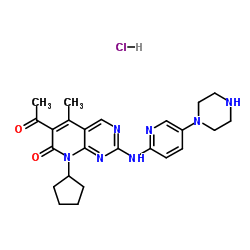PF-3758309 hydrochloride

PF-3758309 hydrochloride structure
|
Common Name | PF-3758309 hydrochloride | ||
|---|---|---|---|---|
| CAS Number | 1279034-84-2 | Molecular Weight | 483.994 | |
| Density | N/A | Boiling Point | N/A | |
| Molecular Formula | C25H31ClN8OS | Melting Point | N/A | |
| MSDS | N/A | Flash Point | N/A | |
Use of PF-3758309 hydrochloridePF-3758309 hydrochloride is a potent, orally available, and reversible ATP-competitive inhibitor of PAK4 (Kd= 2.7 nM; Ki=18.7 nM). PF-3758309 hydrochloride has the expected cellular functions of a PAK4 inhibitor: inhibition of anchorage-independent growth, induction of apoptosis, cytoskeletal remodeling, and inhibition of proliferation[1][2][3]. |
| Name | Palbociclib HCl |
|---|---|
| Synonym | More Synonyms |
| Description | PF-3758309 hydrochloride is a potent, orally available, and reversible ATP-competitive inhibitor of PAK4 (Kd= 2.7 nM; Ki=18.7 nM). PF-3758309 hydrochloride has the expected cellular functions of a PAK4 inhibitor: inhibition of anchorage-independent growth, induction of apoptosis, cytoskeletal remodeling, and inhibition of proliferation[1][2][3]. |
|---|---|
| Related Catalog | |
| Target |
PAK4:18.7 nM (Ki) PAK1:13.7 nM (Ki) PAK5:18.1 nM (Ki) PAK6:17.1 nM (Ki) PAK2:190 nM (IC50) PAK3:99 nM (IC50) PAK4:2.7 nM (Kd) |
| In Vitro | PF-3758309 hydrochloride has similar enzymatic potency against the kinase domains of the other group B PAKs (PAK5, Ki=18.1 nM; PAK6, Ki=17.1 nM) and group A PAK1 (Ki=13.7 nM), but is less active against the other two group A PAKs (PAK2, IC50=190 nM; PAK3, IC50=99 nM)[1]. In cells, PF-3758309 hydrochloride inhibits phosphorylation of the PAK4 substrate GEF-H1 (IC50=1.3 nM) and anchorage-independent growth of a panel of tumor cell lines (IC50=4.7 nM)[1]. PF-3758309 hydrochloride also inhibits endogenous pGEF-H1 accumulation in HCT116 cells. PF-3758309 potently inhibits cellular proliferation (IC50=20 nM) and anchorage-independent growth (IC50=27 nM) of A549 cells[1]. |
| In Vivo | PF-3758309 hydrochloride (7.5-30 mg/kg; p.o.; twice daily for 9-18 days) results in statistically significant tumor growth inhibition (TGI) in HCT116 and A549 models[1]. Animal Model: Female nu/nu, CRL breed 6–8 weeks old mice (bearing HCT116 and A549 tumors)[1] Dosage: 7.5-30 mg/kg Administration: Oral administration; twice daily for 9-18 days Result: Significant tumor growth inhibition (TGI) in HCT116 and A549 models. |
| References |
[2]. Zhao ZS, et al. Do PAKs make good drug targets? F1000 Biol Rep. 2010 Sep 23;2:70. |
| Molecular Formula | C25H31ClN8OS |
|---|---|
| Molecular Weight | 483.994 |
| Exact Mass | 483.214966 |
| Pyrido[2,3-d]pyrimidin-7(8H)-one, 6-acetyl-8-cyclopentyl-5-methyl-2-[[5-(1-piperazinyl)-2-pyridinyl]amino]-, hydrochloride (1:1) |
| Palbociclib hydrochloride |
| UNII:BKC4F3Q5XL |
| Palbociclib HCl |
| 6-Acetyl-8-cyclopentyl-5-methyl-2-{[5-(1-piperazinyl)-2-pyridinyl]amino}pyrido[2,3-d]pyrimidin-7(8H)-one hydrochloride (1:1) |